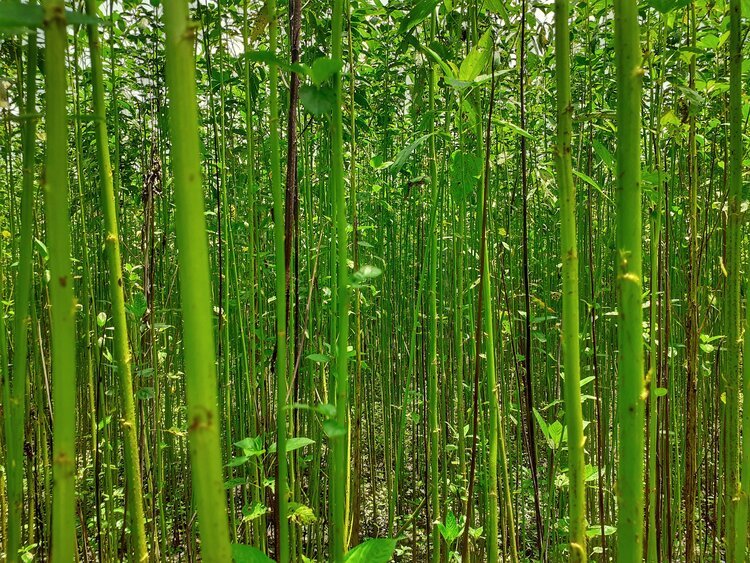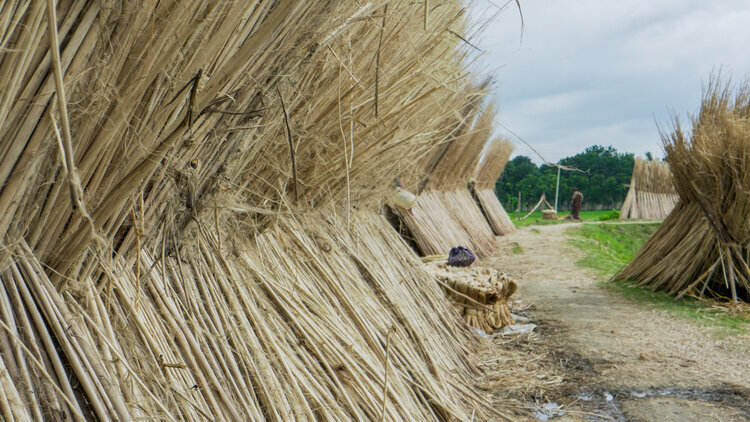i have always wanted to write about this, because it is one of the main reasons i got interested in jute at all - apart from the amazing aesthetics, that sort of fibrous, raw, utilitarian, functional, “textile brute” appeal (which is worth another blog post at some other time). but right now, it’s time to talk sustainability because the textile industry is one of the worst offenders in the world when it comes to pollution and the responsibility is ours, designers, to find alternatives that are friendlier to our environment. jute is an amazing choice for this use too, and below i listed the main reasons of its sustainability benefits.
1. SMALL WATER FOOTPRINT
the jute plant grows in the tropical regions, in countries such as india, bangladesh, pakistan, thailand and southern china and it is also cultivated in many south american countries. it relies on natural rainfall, reducing the need of complicated irrigation systems and require fewer freshwater sources.
2. SMALL LAND FOOTPRINT
the jute plants grow very densely to each-other and crops are produced very efficiently, a decent crop can be cultivated on a smaller piece of land that doesn’t take a lot of space away from natural habitats or other agriculture.
3. REDUCED NEED FOR CHEMICALS
this density by which it grows leaves little space for weeds or other pests, and as such, it’s grown without a huge amount of pesticides. they also don’t need a huge amount of fertilisers either (typically less than 20 kg per hectare is applied)
4. SOIL HEALTH
growing jute plant leaves the soil with more nutrients than before the process. this is because their leaves drop often, creating organic matter that is feeding the soil with nutrients. growing jute can be used in poor quality soils to regenerate waste lands and help with food agriculture in some of the most impoverished regions in the world.
5. CARBON CAPTURE
the jute plant binds carbon dioxide faster than trees and it’s good at releasing oxygen (one hectare of jute plants can consume about 15 tons of CO2 from atmosphere and release about 11 tons of oxygen in the 100 days of the jute-growing season)
6. fast growth
jute plants reach growth in 4-6 months, meaning crops can be harvested a few times a year, this is not only highly economical, but also a sustainable pace and more in line with demand.
7. recyclable and biodegradable
while some of the jute plant is not used at the moment, all production waste is recycled and all of it is biodegradable in its natural form.
8. under-utilised potential for the paper industry
the inside fibres of the jute plants (jute sticks) are still considered waste and are recycled, however, research is ongoing into using it for paper production. it could potentially supply the paper industry with pulp, reducing the need for cutting down trees.
9. production
jute is a utilitarian, industrial fabric, usually woven to lower quality standards requiring less energy-heavy processing and a reduced amount of chemicals. most of the industry uses it in its natural, unbleached form.
10. long life-cycle
jute is a strong and durable fibre, often used for ropes, rugs, heavy duty bags and tarpaulins. it has a long life-cycle before it breaks down (and when it does, it is fully biodegradable and recyclable)
it is clear that jute is a wonderfabric which, if we could accept it being used more widely, could help our living situation on this planet. having said all of that, it is also important that we don’t brush over the inconvenient truths as well - jute is a hard fibre, and to soften it enough to make it spinnable, the industry killed a lot of whales for its oil in the last centuries. this is now replaced with other oils such as paraffin and palm oil which bear their own negative effects, however the industry is continuously working on reducing the necessary amounts of these materials. there is also research that the retting process (also used in flax and hemp production) can also be damaging to aquatic life which is yet to be resolved - unfortunately the textile industry remains an environmentally impactful one.
all in all though, when compared with other materials, jute comes out as one of the best ones. (according to the higgs index of sustainability and impact, natural jute has an overall score of 40, while, for instance, dyed cotton has an impact score 101. jute's water scarcity impact is 10 times less of cotton products.) when it comes to the responsibility of the textile industry, it is absolutely imperative that we use materials that cause the least possible harm to our living environment.
for me, jute and its industrial, raw, functional nature brings also an immense aesthetic value that fits into my design values - i think great parallels can be drawn with the raw concrete as the preferred external material and the functional architecture that is a great source of inspiration of the designs themselves - perhaps it’s worth expanding on that in another blogpost. nevertheless, i hope that in the future, we will see more and more of jute coming into the cosy, warm homes, bringing us the tactile comfort and the environmental benefits - for a more content home, inside and in the wider world too.
-
links:
the sustainable fashion collective
images: adobe stock photos



